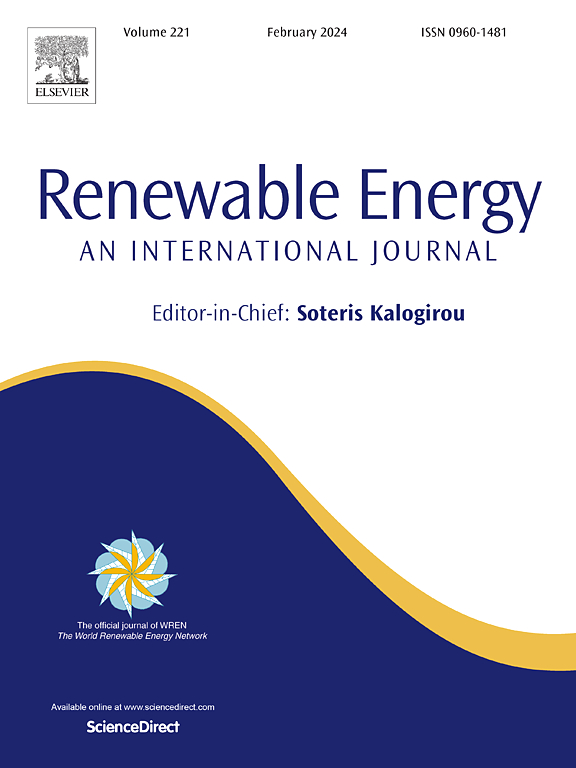Integrated carbon capture and renewable technologies for carbon neutral energy hubs: A network-ready superstructure model
IF 9.1
1区 工程技术
Q1 ENERGY & FUELS
引用次数: 0
Abstract
This study presents a comprehensive superstructure model for carbon-neutral energy hubs, integrating Carbon Capture, Utilization and Storage (CCUS) with renewable technologies. The model addresses the significant energy demands of CCUS processes, particularly in cooling, heating, and CO2 compression, by incorporating an Organic Rankine Cycle (ORC) to enhance overall energy efficiency. The proposed framework features an energy-efficient CO2 removal unit capable of sepa1rating up to 130,000 kg/h of CO2, with the ORC integrated into the compression stages' intercoolers. Parabolic Trough Collector (PTC) and photovoltaic (PV) technologies are incorporated to meet heating and power demands, while batteries provide electrochemical energy storage for multi-vector energy management. This integration enables sustainable electrical power production of up to 9.5 MW. The superstructure is designed as a flexible, network-ready template for carbon-neutral energy nodes, adaptable to various industrial settings and scalable for broader energy networks. Sensitivity analyses identify the optimal CCUS operating conditions and structural configuration, revealing that the system's total heating demand and power consumption are most sensitive to the CO2 removal units' operating pressure and structural parameters. The model's versatility is demonstrated through its application to blue hydrogen production, integrating a hydrogen-based power and heat generation unit for methane reforming at 24 bar and 700 °C. This conceptual design offers a modular approach to developing interconnected, carbon-neutral energy systems across diverse industrial applications, paving the way for large-scale industrial decarbonization strategies.
碳中和能源枢纽的综合碳捕获和可再生技术:一个网络就绪的上层建筑模型
本研究提出了碳中和能源中心的综合上层建筑模型,将碳捕获、利用和储存(CCUS)与可再生技术相结合。该模型通过结合有机朗肯循环(ORC)来提高整体能源效率,解决了CCUS过程的重大能源需求,特别是在冷却、加热和二氧化碳压缩方面。拟议的框架具有节能的二氧化碳去除装置,能够分离高达130,000 kg/h的二氧化碳,ORC集成到压缩级的中间冷却器中。采用抛物槽集热器(PTC)和光伏(PV)技术来满足加热和电力需求,而电池提供电化学能量存储以实现多矢量能量管理。这种集成可以实现高达9.5兆瓦的可持续电力生产。上层建筑被设计成一个灵活的、网络就绪的模板,用于碳中和能源节点,适应各种工业环境,并可扩展到更广泛的能源网络。灵敏度分析确定了CCUS的最佳运行条件和结构配置,表明系统的总供热需求和功耗对CO2脱除装置的运行压力和结构参数最为敏感。该模型的多功能性通过其在蓝色氢气生产中的应用得到了证明,该模型集成了一个氢基发电和产热单元,用于在24巴和700°C下进行甲烷重整。这一概念设计提供了一种模块化的方法,可以在不同的工业应用中开发相互关联的碳中性能源系统,为大规模的工业脱碳战略铺平道路。
本文章由计算机程序翻译,如有差异,请以英文原文为准。
求助全文
约1分钟内获得全文
求助全文
来源期刊

Renewable Energy
工程技术-能源与燃料
CiteScore
18.40
自引率
9.20%
发文量
1955
审稿时长
6.6 months
期刊介绍:
Renewable Energy journal is dedicated to advancing knowledge and disseminating insights on various topics and technologies within renewable energy systems and components. Our mission is to support researchers, engineers, economists, manufacturers, NGOs, associations, and societies in staying updated on new developments in their respective fields and applying alternative energy solutions to current practices.
As an international, multidisciplinary journal in renewable energy engineering and research, we strive to be a premier peer-reviewed platform and a trusted source of original research and reviews in the field of renewable energy. Join us in our endeavor to drive innovation and progress in sustainable energy solutions.
 求助内容:
求助内容: 应助结果提醒方式:
应助结果提醒方式:


